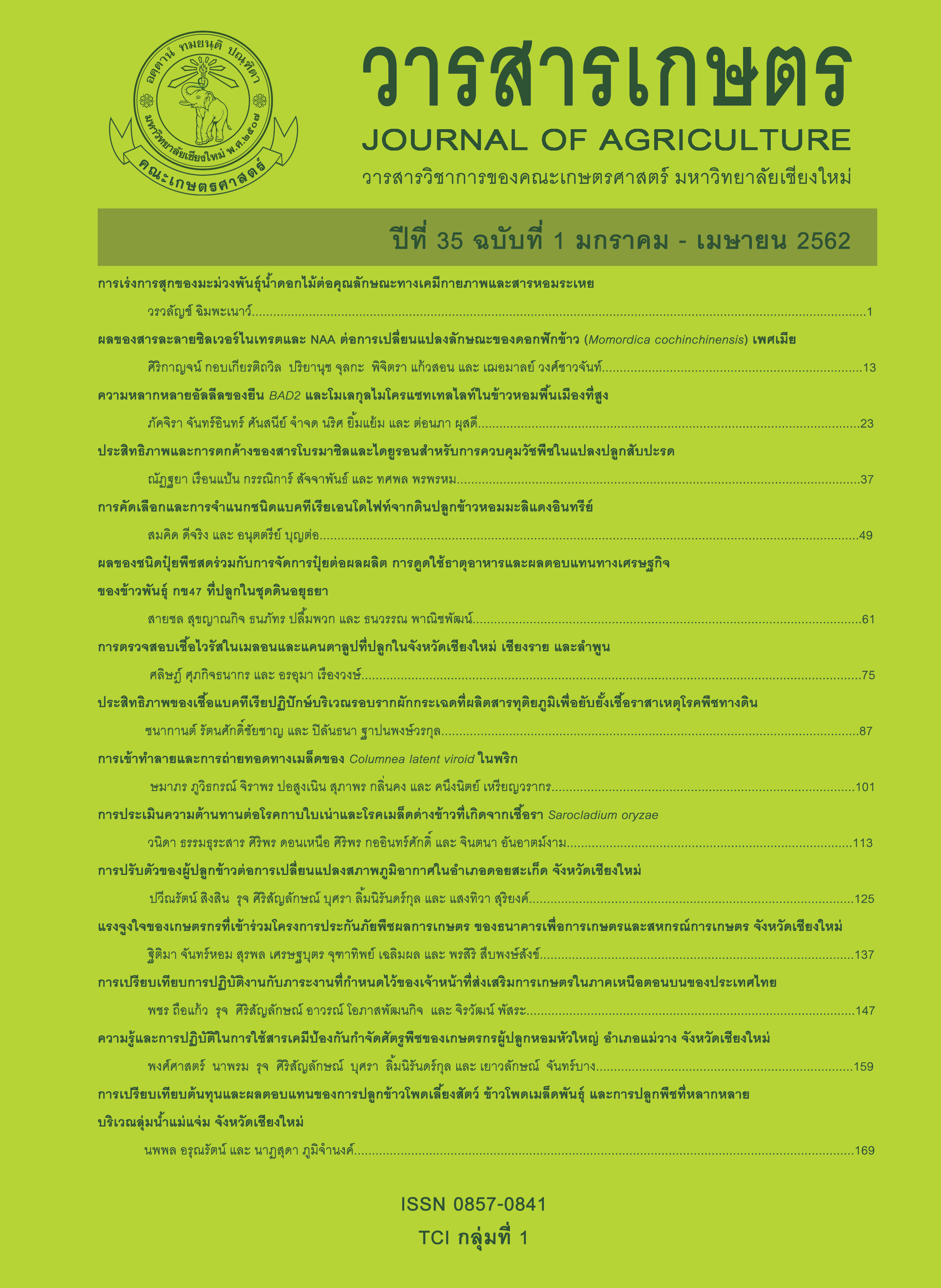ความหลากหลายอัลลีลของยีน <I>BADH2</I> และโมเลกุลไมโครแซทเทลไลท์ในข้าวหอมพื้นเมืองที่สูง
Main Article Content
บทคัดย่อ
ความหอมเป็นหนึ่งในลักษณะคุณภาพเมล็ดที่ทำให้ข้าวหอมมีมูลค่าสูง ในตลาดโลก เนื่องจากมีกลิ่นหอมที่เป็นเอกลักษณ์ ในขณะที่ความต้องการบริโภคข้าวหอมก็เพิ่มสูงขึ้นทั่วโลก ข้าวพันธุ์พื้นเมืองมีลักษณะทางพันธุกรรมที่เป็นเอกลักษณ์ มีความหลากหลายทางพันธุกรรมสูง และพบว่าบางประชากรข้าวพื้นเมืองเป็นข้าวที่มีกลิ่นหอม ดังนั้นงานวิจัยนี้จึงมีวัตถุประสงค์เพื่อประเมินความหลากหลายทางพันธุกรรมและอัลลีลของยีนที่ควบคุมลักษณะความหอมในข้าวหอมพื้นเมืองที่สูงทางภาคเหนือของประเทศไทย โดยประเมินความหลากหลายทางพันธุกรรมด้วยเครื่องหมายโมเลกุล microsatellite จำนวน 12 ตำแหน่ง และประเมินความหอมในเมล็ดข้าวด้วยวิธีการเบื้องต้นโดยการดมและประเมินปริมาณสาร 2-acetyl-1-pyrroline (2AP) ด้วยวิธี headspace - gas chromatography (HS-GC) รวมทั้งศึกษาอัลลีลบริเวณเอกซอน 7 ของยีน BADH2 จากการศึกษาพบว่าข้าวพันธุ์ บือเนอมู มีค่าความหลากหลายภายในประชากรต่ำ (HS = 0.015) แต่มีค่าความแตกต่างระหว่างประชากรสูง (FST = 0.941) ซึ่งอาจเป็นผลมาจากการคัดเลือกในลักษณะความหอมและรูปร่างเมล็ดของเกษตรกร รวมถึงการเปลี่ยนแปลงความถี่ของอัลลีล (genetic drift) จากกระบวนการ genetic bottleneck ซึ่งเป็นผลมาจากการเก็บเมล็ดพันธุ์ของเกษตรกรสำหรับปลูกในปีถัดไป และการปรับตัวให้เข้ากับสภาพแวดล้อมท้องถิ่น ความหลากหลายของ BADH2 อัลลีลในกลุ่มประชากรข้าวบือเนอมูทั้ง 9 โดยประชากร ข้าวบือเนอมู 4 มีปริมาณ 2AP สูงที่สุด (2.96 ppm) และมีการขาดหายไปของยีน BADH2 แบบ badh2-E7 ที่คล้ายคลึงกับข้าวพันธุ์ขาวดอกมะลิ 105 และปทุมธานี 1 ที่เป็นพันธุ์ข้าวหอมยอดนิยมของประเทศไทย ซึ่งผลที่ได้ชี้ให้เห็นว่าข้าวพื้นเมืองพันธุ์บือเนอมูสามารถใช้เป็นแหล่งพันธุกรรมเพื่อพัฒนาและปรับปรุงพันธุ์ข้าวหอมได้ โดยการปรับปรุงพันธุ์ให้เป็นสายพันธุ์บริสุทธิ์หรือพัฒนาให้เป็นพันธุ์สมัยใหม่ นอกจากนี้การประเมินความหลากหลายทางพันธุกรรมข้าวพันธุ์พื้นเมืองยังสามารถใช้เป็นตัวตัดสินใจในการเลือกแนวทางในการอนุรักษ์พันธุ์ข้าว
Article Details
References
งามชื่น คงเสรี. 2547. คุณภาพข้าวและการตรวจสอบข้าวหอมมะลิไทย. เอกสารวิชาการ. กรมวิชาการเกษตร และ สำนักงานเศรษฐกิจอุตสาหกรรม, กรุงเทพฯ. 124 หน้า.
ฉวีวรรณ วุฒิญาโณ. 2543. ข้าวพื้นเมืองไทย. เอกสารวิชาการ. ศูนย์ปฏิบัติการและเก็บเมล็ดเชื้อพันธุ์ข้าวแห่งชาติ สถาบันวิจัยข้าว กรมวิชาการเกษตร, กรุงเทพฯ. 215 หน้า.
รัตนา ม่วงรัตน์ จารุวรรณ จินดากุล และ วรณัฐ อินปัน-บุตร. 2559. การสกัดร่วมกับการกักเก็บสารหอม 2-Acetyl-1-Pyrroline จากใบเตยด้วยแป้งข้าวเจ้าที่ผ่านการเกิดเจลาติไนเซซันภายใต้สภาวะหม้อนึ่งอัดไอเพื่อใช้เคลือบข้าวขาวพิจิตร. วารสารเกษตร 33(2): 299-310
Ahn, S.N., C.N. Bollich and S.D. Tanksley. 1992. RFLP tagging of a gene for aroma in rice. Theoretical and Applied Genetics 84(7-8): 825-828.
Amarawathi, Y., R. Singh, A.K. Singh, V.P. Singh, T. Mohapatra, T.R. Sharma and N.K. Singh. 2008. Mapping of quantitative trait loci for basmati quality traits in rice (Oryza sativa L.). Molecular Breeding: New Strategies in Plant Improvement 21(1): 49-65.
Bandelt, H.J., P. Forster and A. Rohl. 1999. Median-joining networks for inferring intraspecific phylogenies. Molecular Biology and Evolution 16: 37-48.
Bradbury, L.M.T., R.J. Henry, Q. Jin, R.F. Reinke and D.L.E. Waters. 2005. A perfect marker for fragrance genotyping in rice. Molecular Breeding 16(4): 279-283.
Buttery, R.G., L.C. Ling and B.O. Juliano. 1982. 2-acetyl-1-pyrroline: An important aroma component of cooked rice. Chemistry and Industry 12: 958-959.
Chen, S., Y. Yang, W. Shi, Q. Ji, F. He, Z. Zhan and M. Xu. 2008. Badh2, encoding betaine aldehyde dehydrogenase, inhibits the biosynthesis of 2-acetyl-1-pyrroline, a major component in rice fragrance. Plant Cell 20(7): 1850-1861.
Doyle, J.J. and J.L. Doyle. 1987. A rapid DNA isolation procedure for small quantities of fresh leaf tissue. Focus 12: 13-15.
Goudet, J. 2001. FSTAT version 2. 9. 3. A program to estimate and test gene diversities and fixation indices. (Online). Available: https://www2.unil.ch/popgen/softwares/fstat.htm (October 11, 2016).
Hufbauer, R.A. and G.K. Roderick. 2005. Microevolution in biological control: mechanisms, patterns, and processes. Biological Control 35(3): 227-239.
Kumar, S., G. Stecher and K. Tamura. 2016. MEGA7: Molecular evolutionary genetics analysis version 7.0 for bigger datasets. Molecular Biology and Evolution 33: 1870-1874.
Librado, P. and J. Rozas. 2009. DnaSP v5: A software for comprehensive analysis of DNA polymorphism data. Bioinformatics 25: 1451-1452.
Nei, M. 1973. Analysis of gene diversity in subdivided populations. Proceedings of the National Academy of Sciences of the United States of America 70: 3321-3323.
Okoshi, M., K. Matsuno, K. Okuno, M. Ogawa, T. Itani and T. Fujimura. 2015. Genetic diversity in Japanese aromatic rice (Oryza sativa L.) as revealed by nuclear and organelle DNA markers. Genetic Resources and Crop Evolution 63(2): 199-208.
Ootsuka, K., I. Takahashi, K. Tanaka, T. Itani, H. Tabuchi, T. Yoshihashi and R. Ishikawa. 2014. Genetic polymorphisms in Japanese fragrant landraces and novel fragrant allele domesticated in northern Japan. Breeding Science 64(2): 115-124.
Peakall, R. and P.E. Smouse. 2006. GENALEX 6: genetic analysis in excel. Population genetic software for teaching and research. Molecular Ecology 6: 288-295.
Pritchard, J.K., M. Stephens and P. Donnelly. 2000. Inference of population structure using multilocus genotype data. Genetics 155: 945-959.
Pusadee, T., S. Jamjod, Y. C. Chiang, B. Rerkasem and B. A. Schaal. 2009. Genetic structure and isolation by distance in a landrace of Thai rice. Proceedings of the National Academy of Sciences 106(33): 13880-13885.
Sakthivel, K., R.M. Sundaram, N.S. Rani, S.M. Balachandran and C.N. Neeraja. 2009. Genetic and molecular basis of fragrance in rice. Biotechnology Advances 27(4): 468-473.
Shao, G.N., A. Tang, S.Q. Tang, J. Luo, G.A. Jiao, J. L. Wu and P.S. Hu. 2011. A new deletion mutation of fragrant gene and the development of three molecular markers for fragrance in rice. Plant Breeding 130(2): 172-176.
Shi, W., Y. Yang, S. Chen and M. Xu. 2008. Discovery of a new fragrance allele and the development of functional markers for the breeding of fragrant rice varieties. Molecular Breeding 22(2): 185-192.
Tu, M., B.R. Lu, Y. Zhu and Y. Wang. 2007. Abundant within-varietal genetic diversity in rice germplasm from Yunnan province of China revealed by SSR fingerprints. Biochemical Genetics 45(11-12): 789-801.
Wongpornchai, S., K. Dumri, S. Jongkaewwattana and B. Siri. 2004. Effects of drying methods and storage time on the aroma and milling quality of rice (Oryza sativa L.) cv. Khao Dawk Mali 105. Food Chemistry 87: 407-414.

